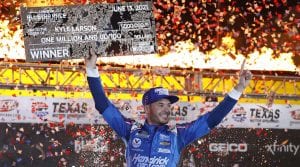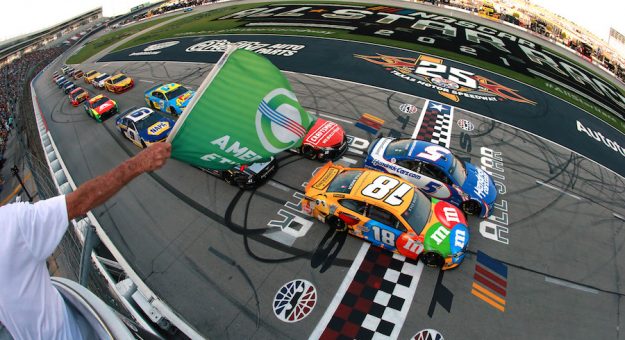Each passing year brings another NASCAR All-Star Race.
And Sunday’s exhibition race at Texas Motor Speedway brings with it another revamped format for teams, fans and drivers to cram to understand before the green flag waves.
“I saw the format,” Denny Hamlin said last weekend at Kansas Speedway. “It just looks like a bunch of fine print to me. So it’s very hard to figure out. I wasn’t in the mindset at the time when I saw come out to try to process the whole thing and what it’s all about.”
If you’re reading this, Denny, here’s what you can expect Sunday night.
Qualifying
Opening round is the traditional single-car, one-lap format in reverse order of the current 2022 owner points.
Fastest eight qualifiers transfer to a three-round, head-to-head elimination bracket.
Elimination bracket will feature two cars staged in adjacent pit stalls near the end of pit road.
At the sound of an alert, each pit crew will perform a four-tire stop and at the drop of the jack, drivers will exit their pit stalls (with no speed limit) onto the track.
First car back to the start/finish line advances to the next round. Final pairing competes for the pole.
Race Format
The race will consist of four stages, with the first three 25 laps in length and the fourth and final being a 50-lap shootout.. The new format has provided a major incentive to win any of the opening three stages or the pit stop competition during the break between Stages 2 and 3.
Stage 1 (25 laps): Stage 1 winner will start on the pole in the final stage as long as he finishes 15th or better in Stages 2 and 3.
Stage 2 (25 laps): Stage 2 winner starts second in final stage as long as he finishes 15th or better in Stage 3.
Special Stage Break (Pit Stop Competition): Each team must pit and perform a four-tire stop. The team with the shortest time on pit road (pit in/pit out) wins the pit crew award and the driver will start fourth in the final stage as long as he finishes 15th or better in Stage 3.
Stage 3 (25 laps): Stage 3 winner starts third in final stage.
Stage 4 (50 laps): Stage 1 winner starts first, Stage 2 winner second, Stage 3 winner third and pit stop competition winner fourth. If a “natural” caution occurs between laps 15-25 of the final stage, standard race procedures will be in effect. If no “natural” caution occurs during that time, NASCAR will call an “All Star” competition caution.
The NASCAR Open will immediately precede the NASCAR All-Star Race and will consist of three stages (20 laps / 20 laps / 10 laps). Each segment winner will advance to the NASCAR All-Star Race as will the winner of the Fan Vote.
__

As usual, the All-Star Race will feature a grand prize of $1 million for the winning driver.
That’s one thing Hamlin thinks needs to be revamped in order to put some spice back into the exhibition race.
“I think that it needs to be a big event,” Hamlin said. “I personally think we need to stop saying it’s for a million dollars (as) our promotion tagline. It’s been that way for 30 years. We’ve got to update a little bit in these times.”
The new qualifying format easily sticks out as an eyebrow raiser.
“I know qualifying is interesting. I saw the qualifying rules,” Joey Logano said at Kansas. “I looked into a little bit of the format, which seems fun. I enjoy that All-Star race. I think everybody does, no matter what the rules are. It’s hard to understand the rule sometimes because it’s so different all the time. It seems like you’re never out of it. There’s a chance to get it one way or another even now down until the last pit stop.”
Of course, this will be the second year the All-Star Race will be held at the 1.5-mile track north of Fort Worth, Texas.
That’s after it was held at Bristol Motor Speedway in 2020 and the previous three decades at Charlotte Motor Speedway. This will be the first time the Next Gen car will get show what its capable of on a track that’s been repaved, reconfigured and treated with the PJ1 traction agent in the last fews years in desperate attempts to make the racing there better.
Teams will also be using the same type of tire that was used last weekend at Kansas.
“I think that gives us a good starting place at least when it comes to what changes we can make with air pressure and the fine line on how the car reacts,” Rudy Fugle, crew chief on William Byron’s No. 24 Chevy, said in a media release. “That’s where practice is going to be the most help since the All-Star Race is broken up into mini races essentially and you don’t have a ton of chances to make big swings and recover by the end.”
Chase Briscoe, who is qualified for the All-Star Race via a race win for the first time, called Texas its “own unique animal” compared to other 1.5-mile tracks.
“The other mile-and-a-halves we’ve ran (this year) they all have multiple grooves where you can run all over the place,” Briscoe said. “You can run up by the wall. You can run the middle. You can run on the bottom. Where Texas is definitely a lot more one-lane dominant, so it’ll be a little bit of a different race just from that standpoint because there’s not as many options to go and get in clean air.
“I think the draft will be a little more relevant here just because of the speeds and everything else. I don’t think you’ll see guys really searching around for lanes as much just because I do think it’s gonna be a lot harder with this car in general at Texas, but also just how the race track is. It’s two totally different ends. You have (Turns 1 and 2) that’s really slow and kind of flat on entry and then you have the other end that’s extremely fast in one lane and pretty close to wide-open, so just how the car handles in both of those corners is totally different and it’ll be interesting to see how this Next Gen car reacts to that.”
